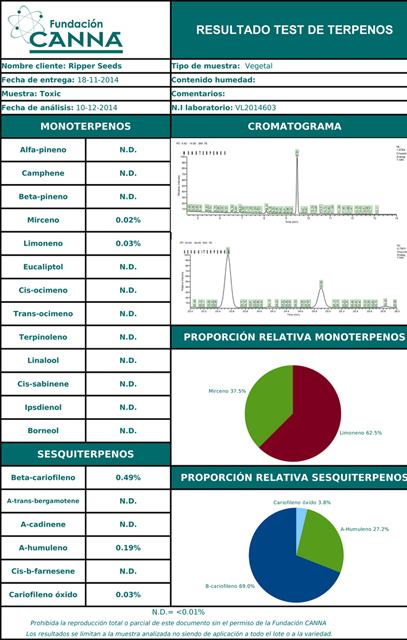Thanks to the Canna Foundation , dedicated to scientific research and analysis of Cannabis, with a very small amount of flower we can become an idea of the terpenoids that a variety has. It should be borne in mind that growing and storage conditions can substantially vary the amount of terpenoids in a sample , but it will generally serve as a guide. In this case, we analyzed a sample of our feminized marijuana seeds Toxic outdoors, with almost three months of air drying without any kind of conservation. Given the data, we can already assume in advance that the sample will have lost a large part of the monoterpenes, which are very volatile, but the relative proportions will remain.

In analysis we can observe several things: First, that the percentages of real terpenoids in the sample are low and that, together with the appearance of sesquiterpene oxides, shows that the sample is slightly oxidized . Second, Toxic, even being a poly hybrid, is a good job at the terpenoid level. Limonene predominates in the relative proportion of terpenoids, but not only that, but there are hardly any traces of other terpenoids other than Limonene and Myrcene. As many of us know Limonene is a highly sought after terpene for extractions and concentrates due to its great return. Here is the Canna Foundation's description of Limonene: "Limonene is the main cyclic carbohydrate component of the essential oil from the skin of lemons and other citrus fruits, and from there it gets its name. It is the second terpene more widely distributed in nature and is an intermediate product in the biosynthesis of other terpenes. Limonene is not found in insects, unlike pinene, but it also has repellent activity as well as insecticide . Limonene It is widely used in the food and pharmaceutical industry as a flavoring. Recently, its use in formulations of dermal patches to improve the transdermal absorption of active ingredients is being studied. In the cosmetic and cleaning products industry, Limonene is used as a fragrance and as an environmentally friendly and biodegradable organic solvent Limonene is rapidly absorbed by inhalation or skin mind and is metabolized rapidly, but there is evidence that it accumulates in fatty tissues such as the brain. Limonene is not toxic or produces skin irritation, but some of its oxidation products by the air are irritating to the skin and mucous membranes , producing 3% of dermatitis in people who have been exposed to high dose and for a long time, as workers in the paint industries, among others. Even so, limonene has therapeutic effects on certain dermatological diseases and antiseptic properties, especially against acne bacteria. Studies in animals suggest that limonene has effects anxiolytics , producing an increase in the neurotransmitters serotonin and dopamine in the brain. It has been shown that the dispersion of limomenum in the environment has produced a decrease in depressive symptoms in hospitalized patients in addition to producing a strong immunostimulation. Limonene also causes apoptosis, or cell death, of breast cancer cells and its effectiveness is currently being tested in clinical trials. Finally, the use of limonene against gastroesophageal reflux has been patented. " The environment of terpenoids and cannabinoids is the most complex, but perhaps little by little and analyzing successive samples we can clarify some other aspects. You can also consult our terpenoid analysis of our feminized marijuana seeds Black Valley.
